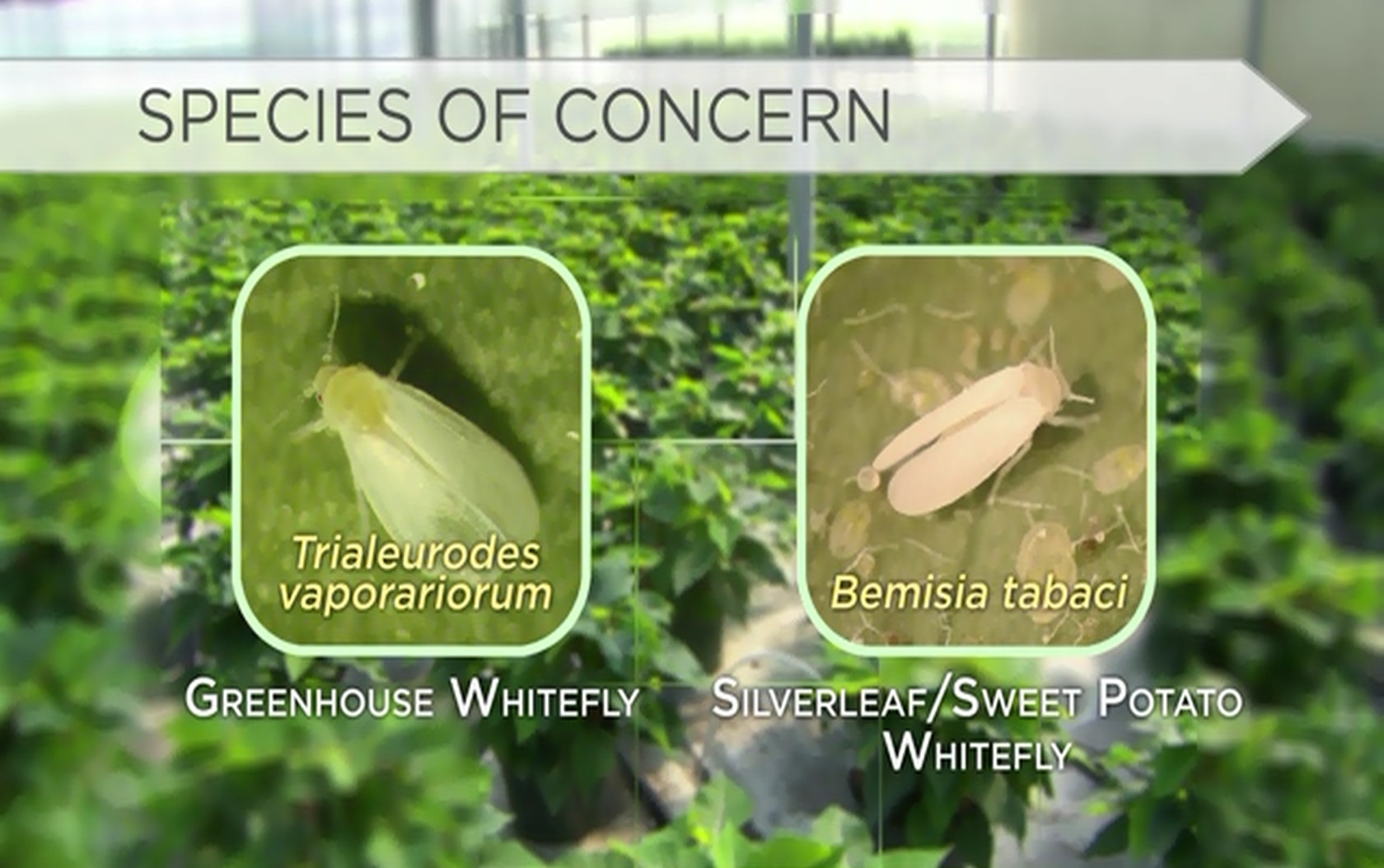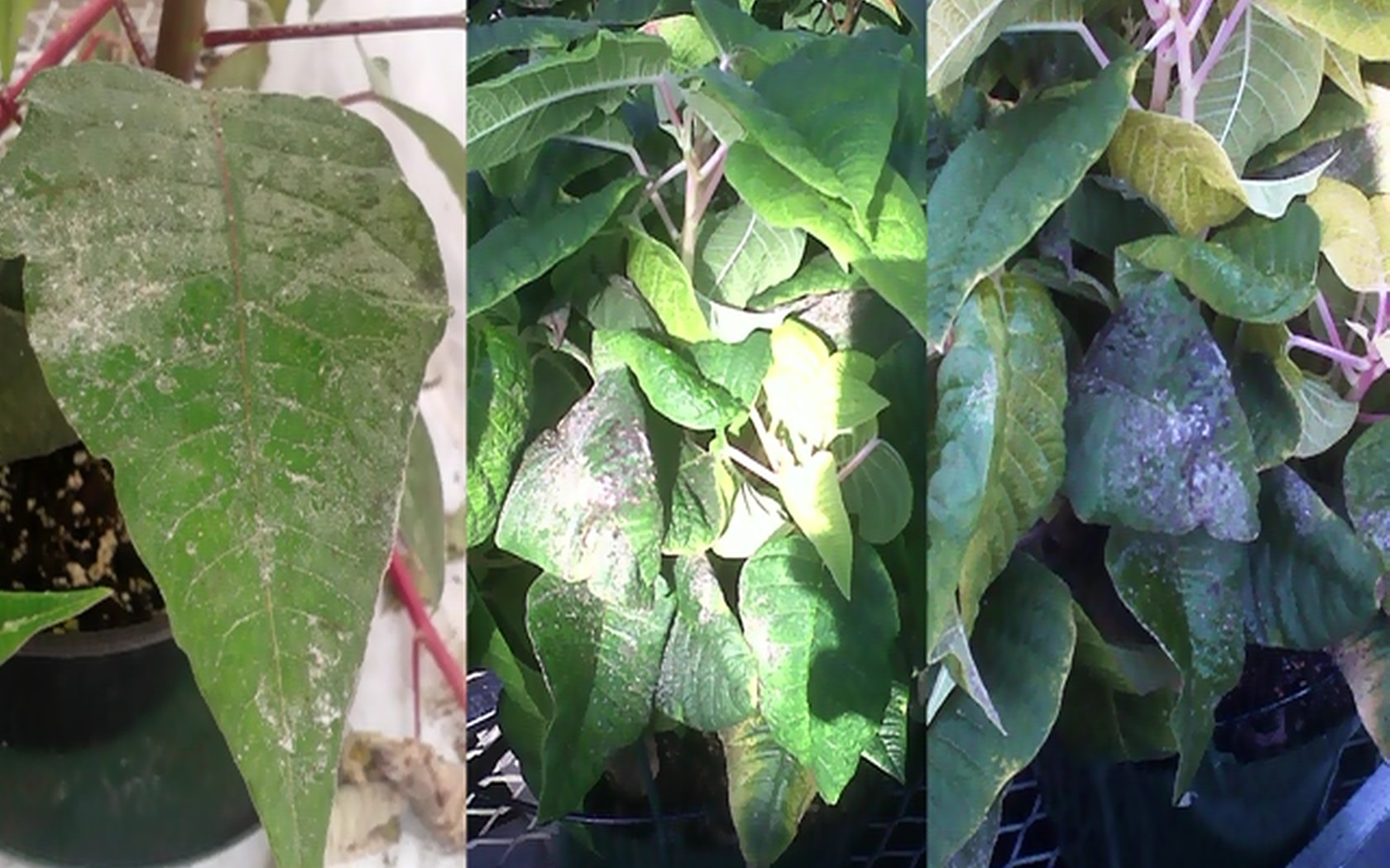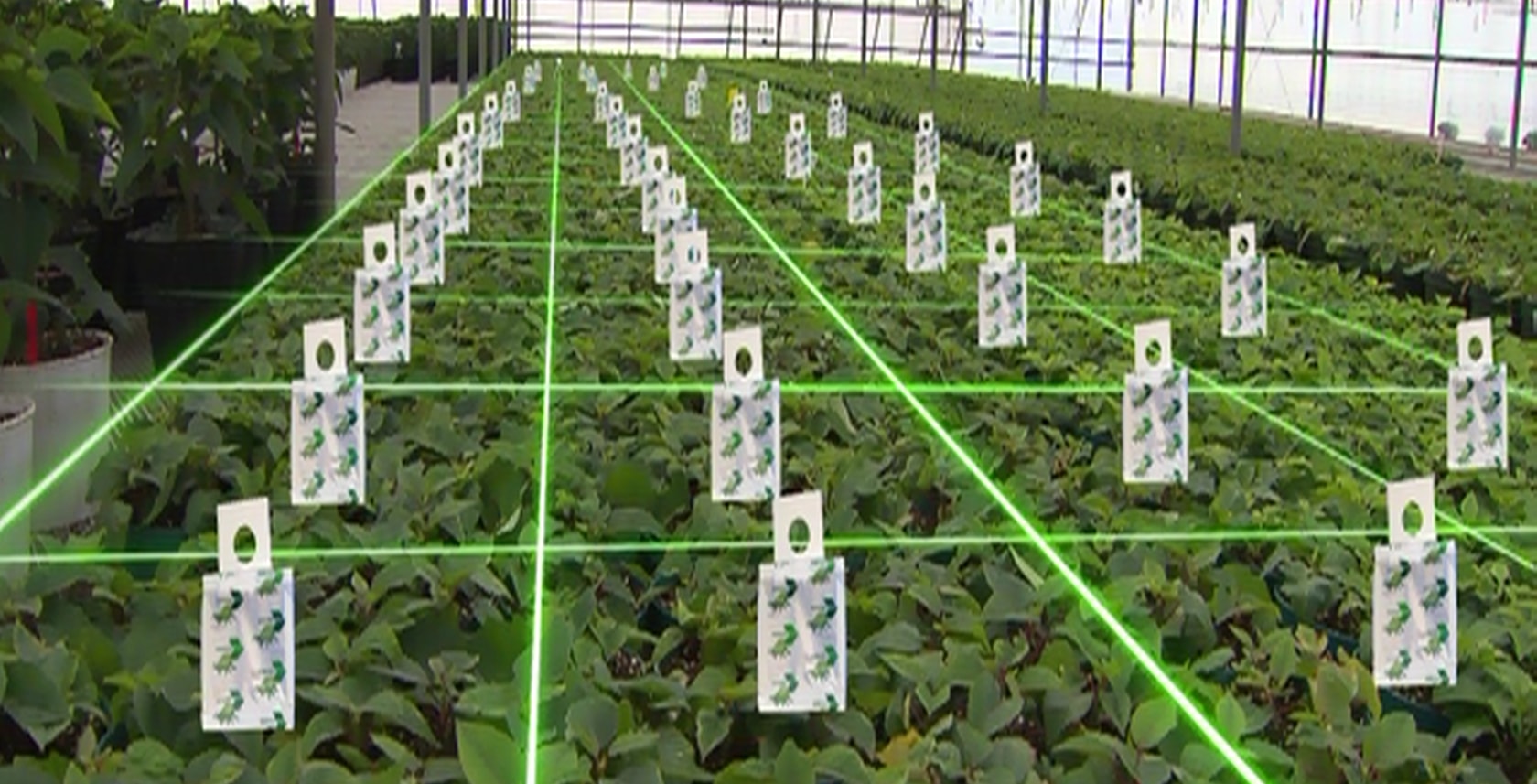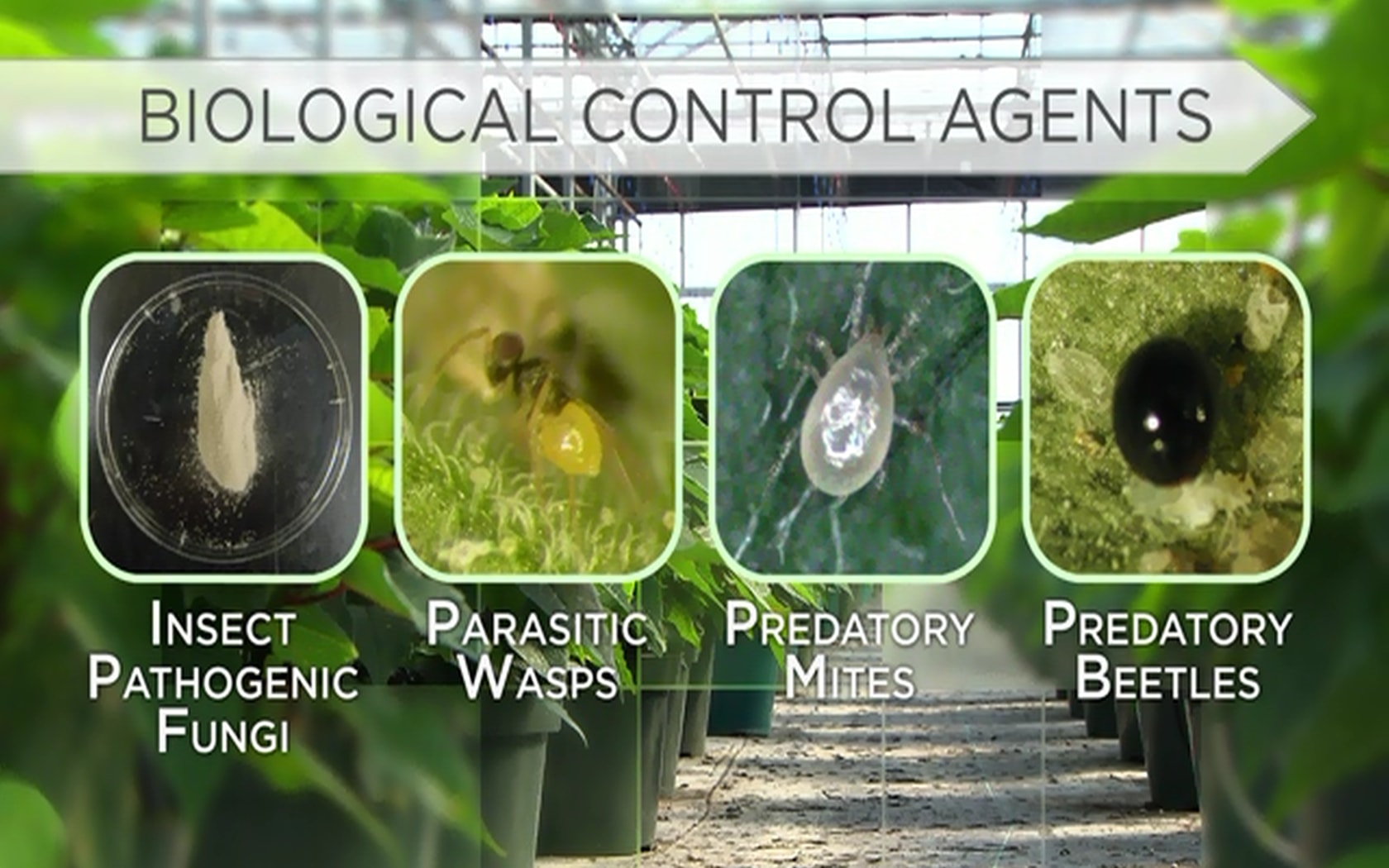Sustainable Crop Protection
Results from the Pesticide Risk Reduction Program
Greenhouse (GH) floriculture growers face many challenges in the management of plant pests, including the wide variety of crops grown, exposure to imported pests from propagation material, limited pesticide products, and no tolerance for cosmetic damage by the consumer. Some Canadian growers, rather than treating these challenges as limitations, have taken the opportunity to become leaders in innovative strategies for managing their pest problems through the use of integrated pest management approaches with a focus on biological control.
Integrated pest management and biological control in the greenhouse
Integrated pest management, commonly abbreviated as IPM, is a knowledge-based pest management system that uses multiple control strategies together to achieve pest management with the lowest possible environmental risk, while also being economically viable.
Biological control is the use of living organisms such as insects, mites, nematodes, fungi and bacteria to control crop pests.
Biological control is a component of many IPM programs and is used in combination with other IPM tools: robust monitoring programs, proper sanitation procedures, physical controls, cultural practices and, if appropriate, compatible conventional pesticides. IPM programs that include biological controls can provide effective and reliable management of GH pests, while reducing risks to workers and limiting the development of resistance to pesticides within pest populations.
Modern tools for modern growers
IPM strategies can be complicated to implement and require a high level of commitment and know-how on the part of the grower. As well, biological control programs can take time to establish and may have higher initial costs when compared to conventional chemical products. To succeed, growers need access to user friendly and independent educational information. The Agriculture and Agri-Food Canada - Pest Management Center (AAFC-PMC) worked with representatives of the GH floriculture industry to develop web-based resources to help guide growers in the use of biological controls and other integrated pest management techniques and practices.
Integrated pest management website for greenhouse crop production

AAFC-PMC provided funding to establish the framework and preliminary content of an IPM centered website, GreenhouseIPM.org (Figure 1). In 2016, the site was updated and re-launched through a multi-stakeholder collaboration. The website provides technical and user-friendly information on integrated pest management and biological controls for GH floriculture and vegetables, with a current focus on two widespread problem pests, thrips and whitefly.
As the site develops, it will evolve to encompass other common insect and mite pests, as well as GH crop diseases. Users can visit the News and Events section of the website for notices about upcoming workshops and seminars and new resources. From this website, users can also access the ONFloriculture blog managed by Ontario Ministry of Agriculture, Food and Rural Affairs (OMAFRA) industry experts for timely, technical information relevant to Ontario greenhouse floriculture growers.
Video series on the management of whitefly in poinsettia production
This three part video series covers a wide range of IPM techniques for addressing whitefly, a serious pest of several GH crops. The videos are available on the GreenhouseIPM website and on Quebec’s Agri-Réseau website (in French only).
Video 1 addresses Monitoring for Whitefly in Poinsettia Crops – This video demonstrates how to accurately identify and monitor two species of whitefly pests [Greenhouse Whitefly (Trialeurodes vaporariorum) and Silverleaf/Sweet Potato Whitefly (Bemisia tabaci) on poinsettia at multiple stages of greenhouse production (Figure 2). Because unrooted cuttings from offshore are known to sometimes carry Bemisia eggs and larvae, emphasis is placed on closely inspecting the plant material when it is received and at regular intervals during production (Figure 3). Viewers are shown the morphological difference between the two pests and how they can cause damage to the plants (Figure 4). The video also shows how to integrate other tactics, such as placing yellow sticky traps to locate problem areas.



Video 2 features Implementing Biological Control for Whitefly in Poinsettia Crops – This video presents several currently available biological controls that can contribute to an IPM program for the management of whitefly. Viewers are shown the type of packaging the agents arrive in (Figure 5); how best to store them and how long their efficacy should last in the greenhouse. They learn how, when and where to apply the agents in the greenhouse in order to obtain successful results (Figure 6). They are shown how to evaluate product quality when they first receive them and activity of the agents in the crop (Figure 7). The video also illustrates how the biological control agent kills its prey (Figure 8). The biological control agents featured include: parasitic wasps (Encarsia formosa, Eretmocerus mundus and Eretmocerus eremicus), the predatory mite Amblyseius swirskii, the black ladybeetle, Delphastus catalinae, as well as biopesticides (entomopathogens Beauvaria bassiana and Isaria fumosorosea) (Figure 9).
Video 3 provides Success stories and mentorship from greenhouse growers using biological controls – In this video, growers that are successfully using biological controls in their greenhouse production share their experiences and discuss the advantages of using biological controls over conventional chemical pesticides to manage pests. It has been shown that increased adoption rates of IPM techniques such as biological control is greatly influenced by grower to grower exchanges.





The videos and website were made possible with funding provided by AAFC-PMC, the International Organization for Biological Control- Nearctic Regional Section and the Ontario Farm Innovation Program, with the collaboration of Flowers Canada Growers, the Vineland Research and Innovation Centre, and OMAFRA.
Contact
Cary Gates
Pest Management Director
Flowers Canada Growers Inc.
Email: cary@fco.ca
Rose Buitenhuis, PhD
Research Scientist, Biological Control
Vineland Research and Innovation Centre
Email: rose.buitenhuis@vinelandresearch.com
About the Pesticide Risk Reduction at Agriculture and Agri-Food Canada
The Pesticide Risk Reduction team delivers viable solutions for Canadian growers to reduce pesticide risks in the agricultural and agri-food industry. The team achieves this goal by funding integrated pest management projects and coordinating pesticide risk reduction strategies developed through consultation with stakeholders and pest management experts. Other sustainable crop protection factsheets are available. For more information please visit the Pest Management Centre.